Previous Page | Right click this page to print.
Oilseed Meals
In the U.S., high-oil seeds are grown primarily for human foodstuffs and industrial products. Oilseed meals are by-products of the processing of high-oil seeds.
Table 6.1 states the total and relative amounts of the top five oilseeds produced in the U.S. in 2001. The data are estimated data.
Oilseed |
Crop Year - 2001 |
|---|---|
Soybeans for beans |
78,668 |
Cottonseed |
6,834 |
Peanuts |
1,923 |
Sunflower |
1,579 |
Canola |
907 |
In
1,000 metric tons; One metric ton equals 2,204.6 pounds |
|
*Estimated |
|
In the U.S., the primary oilseed meals fed to animals are soybean and cottonseed. Oilseed meals are an important high protein feedstuff. In general, oilseed meals fed at moderate levels to most species will produce favorable production results.
The three main processing methods to remove the oil from the oilseed are screw press or expeller, direct solvent, and prepress solvent. For the screw press method, the seed is cracked, dried, cooked, and then extruded through a die. During extrusion, the temperature is closely regulated to inactivate antinutritional factors but not reduce the nutritional value of the feed. Heat applied either too hot or too long will reduce the solubility and biological value of the protein via the Maillard or browning reaction. Feedstuffs, including forages, exposed to excessive heat are susceptible to the reaction. The Maillard reaction results in linkages between carbohydrates and amino acids, thus reducing the availability of the nutrients and therefore nutritional value of the feedstuff. Of the three processing methods, screw pressed or expelled oilseed meals have the greatest lipid content at 4-5%. The second method is direct solvent. Initially, the soybeans are cracked, cooked, ground, and then extracted with hexane or another solvent to remove the lipid. Typically, the process is performed at low temperatures. Then, during solvent recovery, the meal is heated to inactivate antinutritional factors. The third process is prepress solvent. The prepress solvent method is a modified expeller process combined with a solvent extraction process. The resultant oilseed meals have the lowest lipid content.
The following discussion will describe, in general, the nutritional value of oilseed meals. Table 6.2 on page 89 of the text includes the nutrient composition of the oilseed meals. Nutritional value of oilseeds will vary between oilseeds, within a variety of oilseed, between processing methods, etc. Oilseed meals are high in protein. With few exceptions, the minimal crude protein content of oilseed meals is 40% on a dry-matter basis. Prior to marketing, protein content of the oilseed meals is standardized. In terms of protein quality, most of the nitrogen is in the form of true protein. The protein is also highly digestible. Oilseed meals have a moderate to good biological value. However, the biological value of oilseed meals is generally lower than the animal protein feeds. Most oilseed meals are low in cystine and methionine. The lysine content is variable and low in all the oilseed meals except soybean meal. The energy value of the oilseed meals varies greatly between the oilseed meals. Regarding minerals, in general oilseed meals are low in calcium and high in phosphorus. However, at least 50% of the phosphorus is relatively unavailable to monogastrics. Oilseed meals are low to moderate in B vitamin content and low in vitamin E and carotene.
Soybeans are fed to animals as heat processed whole beans and as processed soybean meal. The most common soybean-based product fed to animals is soybean meal. In the U.S., soybean meal is the most important protein supplement for animals.
Figure 6.1 illustrates a field of immature soybeans.
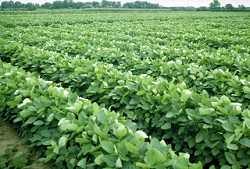
Figure 6.2 illustrates a mature soybean plant.

Figure 6.3 illustrates soybean meal.
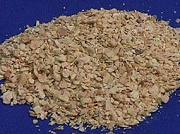
Soybean meal (SBM) has the highest nutritional value of the plant protein sources. Soybean meal is an excellent source of protein. The crude protein content of soybean meal is either 44 or 50% crude protein on an as-fed basis. The amino acid profile of soybean meal is also favorable. For monogastrics, the first limiting amino acid in soybean meal is methionine. Soybean meal is low in cystine and tryptophan. In addition, soybean meal has a high energy value. Soybean meal also has a low fiber content. Soybean meal is low in calcium, phosphorus, carotene, vitamin D, and the B-complex vitamins. Soybean meal is also palatable and digestible.
Soybean meal does have a number of antinutritional factors. For soybeans these include protease inhibitors, lectins, phytoestrogens, saponins, goitrogens, and others. Protease inhibitors interfere with the trypsin and chymotrypsin. Protease inhibitors reduce protein digestion and amino acid utilization. Heat-treatment of the feedstuff will effectively address these antinutritional factors.
Generally, soybean oil will be removed via solvent extraction. The remaining meal is subsequently toasted. Heat treatment improves the nutritional value of the soybean meal.
Soybean meal produces excellent performance results in a number of animal species. In poultry and swine rations, soybean meal is the standard protein supplement. Soybean meal is also commonly used in cattle rations.
In addition to soybean meal, other soybean-based protein feeds include dehulled, solvent-extracted meal, ground, extruded whole beans or full-fat meal, and soy flour. Dehulled, solvent-extracted meal has a higher protein and lower crude fiber content compared to soybean meal. Ground, extruded whole beans or full-fat meal is heated and ground, but not extracted. Soy flour may be used in milk replacer.
In the U.S. the second most important oilseed meal is cottonseed meal (CSM).
Figure 6.4 illustrates cotton seed.
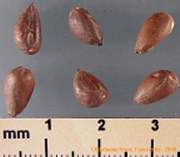
Figure 6.5 illustrates cottonseed meal.
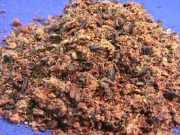
The major cotton-based feedstuffs are whole cottonseed and cottonseed meal. As discussed earlier, whole cottonseed may be fed to ruminants as a combined protein, fat, and fiber source.
The crude protein content of the majority of the cottonseed meal is 41% on an as-fed basis; others may be 44 or 48% crude protein. In general, cottonseed meal has a high protein quality; it varies by processing procedure. Cottonseed meal is low in cystine, methionine, lysine, and tryptophan. For ruminants, cottonseed meal is a good source of rumen inert protein. Compared to soybean meal, the fiber content is higher in cottonseed meal. Regarding minerals and vitamins, cottonseed meal is low in calcium, carotene, and vitamin D and high in phosphorus. Cottonseed meal is palatable for ruminants. Cottonseed is less palatable for monogastrics.
Cottonseed meal has a number of antinutritional factors. The antinutritional factors in cottonseed meal restrict feeding more than the antinutritional factors in soybean meal. Cottonseed meal contains gossypol. Gossypol is a yellow, toxic substance produced by the seed. Chemically, gossypol is a phenolic compound. The free form of gossypol is toxic. Heat processing binds the free gossypol, thus reducing the opportunity for toxicity. Genetic engineering of cottonseed can reduce or eliminate the gossypol gland, therefore reducing gossypol production and the opportunity for toxicity.
Cottonseed meal that has been processed via the screw press method produces the highest levels of free gossypol and the prepress solvent method contains the highest levels of bound gossypol. Monogastrics are more susceptible to gossypol toxicity in comparison to ruminants. The addition of iron salts to the meal will also reduce toxicity. The iron salts bind the free gossypol.
To produce cottonseed meal, the cotton seeds are cleaned and dehulled, the kernels are crushed, extracted by either screw press, solvent, or prepress solvent, and then ground. The majority of cottonseed is either processed using the direct solvent method or the prepress solvent method.
For monogastrics, processing via direct solvent or prepress solvent is recommended. For monogastrics, cottonseed meal may be fed at less than 25% of the total protein supplement. Cottonseed meal is a more suitable feedstuff for ruminants.
Canola meal is a by-product of a specialized rape seed. Traditional rapeseed contains high amounts of erucic acid and glucosinolate. Canola is a specialized rape with low erucic acid and glucosinolate. Canola was developed in Canada and named accordingly; canola is derived from the phrase Canadian low acid rapeseed.
Figure 6.6 illustrates a canola field.
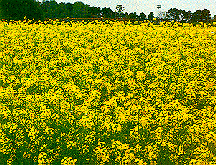
Figure 6.7 illustrates canola seed.
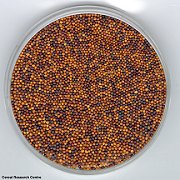
Figure 6.8 illustrates canola meal.
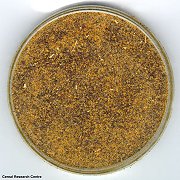
Canola meal contains 41-43% crude protein on a dry-matter basis. Canola meal has a good amino acid profile. Compared to soybean meal, canola meal is lower in lysine and higher in methionine.
Antinutritional characteristics of canola and rapeseed meal include erucic acid, glucosinolates, and tannic acid. Erucic acid and glucosinolates are toxic to animals. Glucosinolates are goitrogenic; inhibiting thyroid metabolism. If canola meal is included in high quantities in the ration, low glucosinolate varieties of canola should be used. Tannic acid is higher in the brown versus the yellow seed varieties.
Canola meal may be fed to both monogastrics and ruminants. In general, the maximum amount to add is limited to 20% of the total ration. For some classes of monogastrics, the maximum amount is lower.
An additional canola-based product is full-fat canola seed. Full-fat canola seed is a high energy and high protein feedstuff. Processing maximizes nutritional value of the full-fat canola seed.
Linseed meal is a by-product of flax oilseed.
Figure 6.9 illustrates a flax plant.

Figure 6.10 illustrates a flax seed.
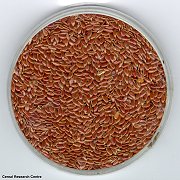
Linseed meal averages 35% crude protein on an as-fed basis. Linseed meal is low in lysine and tryptophan. Linseed meal may be high in selenium, depending on the location where the linseed was grown. Linseed meal is low in carotene and vitamin D and moderate in calcium and the B-complex vitamins.
Antinutritional factors in linseed meal include a cyanogenic glycoside and an antipyridoxine factor. If cost-effective, linseed meal is a favorable protein supplement for ruminants and horses and, at some times, swine. Linseed meal is rarely fed to poultry.
The next oilseed meal is peanut meal.
Figure 6.11 illustrates peanuts on the vine prior to harvest.
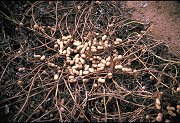
Peanut meal is a high-quality plant-based protein feedstuff. Peanut meal contains 44-55% crude protein. The protein quality varies with processing method and hull content. The digestibility of the protein is relatively low. Peanut meal is low in methionine, lysine, and tryptophan. Peanut meal is also low in calcium, carotene, and vitamin D. Peanut meal is a palatable feed.
An antinutritional characteristic of peanut meal is the presence of fungi. As discussed regarding corn, fungi produce aflatoxins.
An additional peanut-based product fed to animals is peanut meal and hulls. About 25% of the feedstuff is hulls, therefore peanut meal and hulls is higher in fiber than peanut meal.
The next oilseed meal is safflower meal.
Figure 6.12 illustrates a safflower plant.
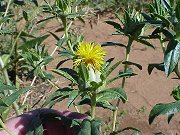
Safflower meal is available as meal with the hulls or partially dehulled meal.
Safflower meal with the hulls is relatively low in protein at 25% crude protein on a dry-matter basis and high in fiber at 32% crude fiber on a dry-matter basis. Partially dehulled meal has a higher nutritional value. The crude protein content is 46% on a dry-matter basis. In addition, partially dehulled safflower meal contains a relatively lower fiber content at 15% crude fiber on a dry-matter basis. Safflower meals are deficient in methionine and lysine.
For monogastrics, use of safflower meal is limited due to the high fiber content. However, dehulled meal may be added to the ration in moderate amounts. Safflower meal is used relatively efficiently by ruminants.
Sesame meal is the next oilseed meal. Sesame meal contains 38-48% crude protein on a dry-matter basis. Sesame meal is low in lysine and adequate in methionine. Sesame meal contains phytic acid. For monogastrics, limit the amount fed.
The final oilseed meal to discuss is sunflower meal. Sunflower meal with hulls contains 26% crude protein on a dry-matter basis and dehulled sunflower meal contains 50% crude protein on a dry-matter basis. Protein quality of sunflower meal is comparable to soybean meal. Sunflower meal is deficient in lysine. Sunflower meal is relatively high in fiber. For monogastrics, the fiber content will limit use. Feeding of the dehulled meal will decrease the fiber content.
In addition to the oilseed meals discussed above, other oilseed meals are listed on page 97 of the text. In the U.S., the use of these oilseed meals as feedstuffs is limited.
Previous Page | Right click this page to print.